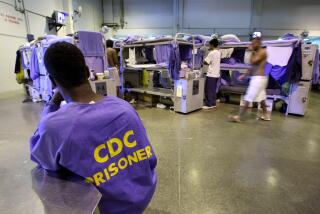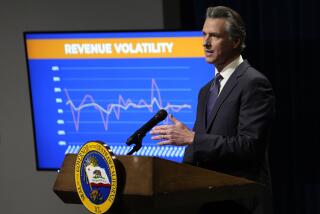Panel Cuts $99 Million From Budget--Aims at Deukmejian’s Projects
- Share via
SACRAMENTO — The Democratic-controlled conference committee on the budget slashed nearly $100 million on Thursday out of programs sought by Gov. George Deukmejian, completing work on a compromise $41.5-billion state spending plan.
Committee staff members estimated that the plan contains a reserve of $953 million, nearly the $1 billion requested by the governor.
Overriding objections from Republicans on the committee, Democratic members voted to cut the governor’s prisons budget by $41 million, trimmed $40 million from the workfare program, and slashed another $18 million from Deukmejian’s Rural Renaissance program.
On top of the cuts, the committee also voted to “readjust” the state spending limit to create more room for expenditures, throwing out one of the key elements that Deukmejian used in figuring what next year’s ceiling would be.
Legislative Analyst Elizabeth G. Hill said the change in the limit would free up about $225 million over the next 13 months.
In one of its final actions, the committee voted to pump an additional $88.8 million in financial aid to counties after resolving a dispute over funding formulas that began when Los Angeles lawmakers complained that the state’s most populous county was not receiving its fair share of the money. As it stands, Los Angeles County will receive about $33 million.
The committee approved the budget on a 5-1 vote, with Assemblyman William P. Baker (R-Danville) casting the lone negative vote. Baker objected strenuously to the cuts aimed at Deukmejian’s programs.
The budget is expected to be voted on by the full Assembly and Senate on Monday, the Legislature’s deadline for sending the spending measure to Deukmejian.
The committee began its ninth day of budget deliberations tired, testy and in a mood to make dramatic reductions to answer Deukmejian’s request that the Legislature’s spending total come close to the $40.8-billion budget he proposed--one that would hold spending under the legal limit and contain a $1-billion reserve.
Forced to cut, the four Democrats chose some of Deukmejian’s top budget priorities for their biggest savings.
Assemblyman William P. Baker (R-Danville), one of the two Republicans on the committee, claimed that the Democrats were “artificially balancing” the budget.
Sen. Alfred E. Alquist (D-San Jose), chairman of the conference committee, noted that the committee in recent days has slashed hundreds of millions in spending from other programs.
“I see no reason why they shouldn’t take the cuts along with health and welfare programs,” Alquist said.
Uncertain Future
Whether Thursday’s actions will stand up remains to be seen.
Deukmejian is armed with a powerful weapon of his own, the budget veto. He has demonstrated in previous years that he is more than willing to use that line-by-line veto.
Technically, Deukmejian can use the veto only to cut programs, thus he will not be free to add back the cuts made by the conference committee.
But in the past he has vetoed money from other programs and set the savings aside to restore the Legislature’s cuts.
The cut of $41 million will come out of the Department of Corrections’ proposed budget of more than $1 billion. The committee basically left it up to the department to decide where to make the individual cuts.
The reduction in the Rural Renaissance program cut into Deukmejian’s much-touted plan for bolstering the economy of rural California.
Assemblyman John Vasconcellos (D-Santa Clara) complained that “I’ve tried to figure out what this program does and so far no one has been able to tell me.” When neither officials of the Department of Finance nor Republican committee members could tell him, Vasconcellos asked again, “What specifically does it do?” and got no answer.
The cut in the workfare program, called Greater Avenues for Independence, or GAIN, was initiated by Assemblywoman Maxine Waters (D-Los Angeles), who said counties were slow in implementing the education-work experience program for welfare recipients and probably could not spend the money anyway.
Surprised Reaction
The proposal to change the spending limit was unveiled Thursday afternoon and caught nearly everyone in the committee hearing room by surprise.
Nancy Ordway, chief deputy director of the Department of Finance, complained that it was “a new issue” that had not surfaced before.
Hill, the legislative analyst, said her office had asked for an interpretation of the spending limit by the legislative counsel’s office months ago but that the answer had not arrived until Wednesday.
“You have more room in the state limit than we originally thought a few days ago,” Hill told the committee.
Basically, the difference stems on how the renters tax credit is computed under the limit. The legal opinion argued that only a refundable portion of the credit should be counted as a state expenditure, even though the full credit is appropriated every year by the Legislature.
Republican Baker, bristling, accused the Democrats of changing the rules on the spending limit at the 11th hour just to make the budget balance.
Despite the last-minute cuts, the budget prepared by the committee is in agreement with Deukmejian’s spending plan in many areas, including the size of wage increases that will be offered to state employees and the level of inflationary increases that will be given to welfare recipients and others receiving monthly living allowances from the state.
In earlier action, the legislative budget writers restored $8 million to continue the state’s industrial worker safety program (Cal/OSHA).
The budget negotiators also added more than $200 million for health programs, including $113.5 million for hospitals and private emergency rooms that treat indigent Californians not served by private or state health plans.
The budget writers rejected Deukmejian’s plan to turn $477 million in local health and welfare programs over to counties. Deukmejian had proposed giving counties responsibility for financing the programs, along with 0.25% of the sales tax.
More to Read
Get the L.A. Times Politics newsletter
Deeply reported insights into legislation, politics and policy from Sacramento, Washington and beyond. In your inbox twice per week.
You may occasionally receive promotional content from the Los Angeles Times.










